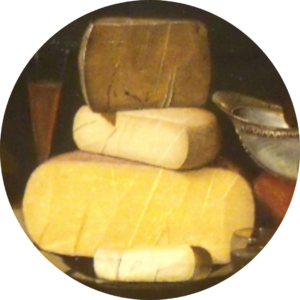Carmenere is a unique grape, with both character and history that stand alone. In taste is runs to herbs and savoury notes, in history it is an orphan of Europe, with no mothership of ancient vineyards to show it the way. And its good with cheese.
Tasting table
| Body | Medium to full body. Acidity, alcohol and tannins are all moderate making it a mouthful without feeling overly heavy |
| Grape flavours | Fruit: Blackberry, black cherry, and plum Herbal: notable herbal and green pepper Spices: black pepper and clove may be present |
| Winemaker flavours | Oak: common. The use of oak barrels, both French and American, imparts aromas such as vanilla, cedar, and toasted notes. Malolactic Conversion: softens the wine’s acidity and can give creamy smoother notes |
| Aged flavours | Herbal notes mellow; dark fruit flavours evolve to dried fruit with hints of fig and raisin. Oak-influences of earthiness, vanilla and spice may rise |
Chilean Carmenere Vines – A mystery and a Miracle
Chilean Carmenere wine has a fascinating history that stretches back centuries and has evolved into a significant part of Chile’s viticultural heritage. This story involves the rediscovery of an almost-lost grape variety, its adaptation to the Chilean terroir, and the emergence of distinct appellations and crus.
Carmenere is originally a Bordeaux grape variety, known for its deep red color, rich flavors, and ability to thrive in the Bordeaux region of France. However, in the mid-19th century, a devastating phylloxera epidemic struck Bordeaux, decimating vineyards and leading to the replanting of many grape varieties. Carmenere was thought to be extinct, and its vines were abandoned in France.
Unbeknownst to many, some Carmenere vines had been transported to Chile in the 19th century before the phylloxera crisis hit Bordeaux. These vines found a new home in Chile’s fertile soils and Mediterranean climate, where they flourished and remained undiscovered for decades.
The rediscovery of Carmenere in Chile took place in the late 20th century. In the 1990s, viticulturists and winemakers began to realize that some Merlot vines in Chile were producing distinctive and unusual wines. DNA testing eventually confirmed that these vines were actually Carmenere, a grape thought to be extinct. This revelation sparked interest and excitement in Chilean wine circles, leading to the resurgence of Carmenere as a unique and valuable grape variety.
Chilean Carmenere wine is now grown in several regions across the country, with each region contributing its own characteristics to the wines.
- Central Valley: The Central Valley, encompassing the Maipo, Rapel, and Curicó Valleys, is the heart of Chilean wine production and the primary region for Carmenere. The Maipo Valley, in particular, is known for producing robust and structured Carmenere wines. The region’s combination of warm days and cool nights helps Carmenere grapes ripen fully while retaining their acidity and flavors.
- Colchagua Valley: Colchagua Valley, a sub-region of Rapel Valley, has gained recognition for its exceptional Carmenere wines. Located to the south of Maipo, Colchagua enjoys a warmer and drier climate, resulting in ripe and full-bodied Carmenere wines with rich fruit flavors and soft tannins.
- Cachapoal Valley: Another sub-region of Rapel Valley, Cachapoal Valley is known for its well-balanced Carmenere wines. The valley’s climate is moderated by its proximity to the Pacific Ocean, allowing for slower ripening and the development of complex flavors in the grapes.
- Maule Valley: Located further south, Maule Valley has been a traditional source of Carmenere grapes. The region’s cooler climate produces Carmenere wines with a fresh, vibrant character and bright red fruit flavors.
As Chilean winemakers honed their skills with Carmenere, they began to focus on specific appellations and crus to showcase the grape’s diversity and terroir-driven expressions. Notable appellations and crus include:
- Apalta: Within the Colchagua Valley, Apalta is renowned for producing some of Chile’s finest Carmenere wines. Its unique microclimate and terroir impart elegance and complexity to the wines, often characterized by deep purple hues and layered flavors.
- Peumo: In the Cachapoal Valley, the Peumo appellation is recognized as the birthplace of Carmenere in Chile. The area’s old-vine Carmenere vineyards produce wines with remarkable depth and concentration, displaying the grape’s true potential.
- Los Lingues: Situated in the foothills of the Andes Mountains, Los Lingues in Colchagua Valley offers high-altitude Carmenere vineyards. The combination of altitude and climate results in wines that display great structure and freshness.
The United States
Chilean Carmenere is new to American wine lovers but as more Chilean wineries began exporting their wines, this unique variety with its unusual story has gained traction.
It has two main assets – affordability and easy drinking. Dark fruit, herbal notes, and soft tannins appeal to those looking for wines that are both fruit-forward and food-friendly. It pairs well from grilled meats to pasta and even spicy dishes.
Chilean wineries have also actively promoted Carmenere through tastings, wine events, and marketing campaigns in the United States. This marketing effort has helped raise awareness about Carmenere and its unique story, further contributing to its popularity.
Tasting Notes
- Body: Medium to full body. Acidity, alcohol and tannins are all moderate giving a lush and velvety texture without feeling overly heavy.
- Grape Flavours:
- Dark Fruit: blackberry, black cherry, and plum being prominent. These flavours are often ripe and juicy, contributing to the wine’s luscious profile.
- Herbal Notes: Carmenere is characterized by notable herbal and green pepper notes. These herbal elements are central to its identity and are the base of its flexibility with food pairing
- Spices: black pepper and clove may also be present
- Wine Maker Techniques:
- Oak Flavoring: Oak aging is common. The use of oak barrels, both French and American, imparts aromas such as vanilla, cedar, and toasted notes.
- Malolactic Conversion: Malolactic fermentation is often used to soften the wine’s acidity and enhance its mouthfeel. It can result in creamy, buttery notes that harmonize with Carmenere’s fruit and herbal elements.
- Aging: Better wines are aged but most are consumed at a younger age. When Carmenere is aged herbal notes can mellow, and dark fruit flavours may evolve into dried or preserved fruit with hints of fig and raisin. The oak-influenced characteristics, such as vanilla and spice, become more pronounced. Tertiary flavours like leather, tobacco, and earthy notes can develop.
Chile vs Bordeaux and Italy
While winemakers have there individual interpretations, Chilean Carmenere as a whole can be seen to be distinct from those of Bordeaux, where Carmenere originated, and from regions like Italy.
Chilean Carmenere vs. Bordeaux Carmenere:
- Climate: Bordeaux, located in southwestern France, has a maritime climate with milder temperatures and more rainfall than Chile’s Mediterranean climate. This difference in climate affects the ripening process. Chilean Carmenere often achieves riper fruit flavors due to the warmer, sunnier climate.
- Herbal Notes: While both Chilean and Bordeaux Carmenere can display herbal notes, Chilean Carmenere is more likely to exhibit pronounced green pepper and herbal characteristics. These notes can be more subtle in Bordeaux Carmenere.
- Fruit Profile: Chilean Carmenere often showcases riper and more intense dark fruit flavors like blackberry and plum. Bordeaux Carmenere may have a slightly leaner fruit profile with red fruit notes.
- Tannins: Chilean Carmenere typically has smoother, more approachable tannins compared to Bordeaux Carmenere, which can have firmer and grippier tannins, particularly in its youth.
- Oak Aging: Both regions use oak aging, but the style of oak and its impact can differ. Bordeaux often uses French oak, imparting subtle vanilla and cedar notes, while Chilean Carmenere may utilize American oak, contributing more pronounced vanilla and sometimes coconut flavors.
Chilean Carmenere vs. Italian Carmenere (Rarissimo):
- Terroir: Italian Carmenere, known locally as “Rarissimo,” is grown in the Friuli Venezia Giulia region of northeastern Italy. This region has a cooler, continental climate and unique soil types, which result in different terroir characteristics compared to Chile.
- Fruit Profile: Italian Carmenere tends to display brighter red fruit flavors, such as red cherry and raspberry, with less emphasis on the dark fruit notes often found in Chilean Carmenere.
- Acidity: Due to the cooler climate, Italian Carmenere often has higher acidity, providing more vibrancy and freshness in the wine compared to the moderate acidity of Chilean Carmenere.
- Tannins: Tannins in Italian Carmenere can be more prominent and structured than those in Chilean Carmenere, giving the wine a different textural quality.
- Herbal Notes: While both regions may exhibit herbal notes, the herbal character in Italian Carmenere is often more restrained and subtle compared to the more pronounced green pepper and herbal notes in Chilean Carmenere.
- Winemaking Styles: Italian Carmenere may be produced in a more Old World style, emphasizing terroir expression and balance, while Chilean Carmenere can exhibit a New World style with a focus on ripe fruit and oak influence.
In summary, Chilean Carmenere differs from other interpretations of the grape due to variations in climate, terroir, winemaking techniques, and regional traditions. Chilean Carmenere tends to have riper, darker fruit flavors, smoother tannins, and more pronounced herbal notes compared to Bordeaux and Italian Carmenere. These differences reflect the unique characteristics of the Chilean terroir and winemaking style, making Chilean Carmenere a distinctive and flavorful wine in its own right.


